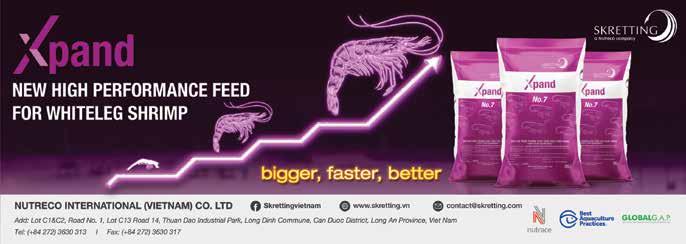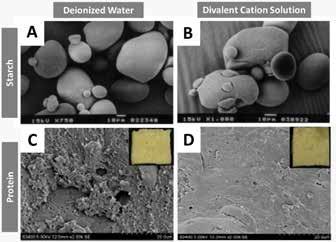
9 minute read
A new normal in shrimp feed processing
A relook at the inadequacy of pelleted shrimp feed
By Steven Goh
With rising raw material costs affecting aquafeed prices, and farmers struggling with low survival rates from pond water quality and the constant threats of diseases, the future for shrimp farming is dauntingly more challenging. Rising feed additive costs and questionable feed quality add more difficulties and uncertainties to the sustainability of shrimp farming. Besides providing adequate nutritional needs and water stability, pellet integrity and density are areas of great concern in shrimp feed processing. This impacts nutrient leaching into the water and the desired sinking rate of the pellets.
The crucial question is “What more can be done to improve farm productivity and survival rates?” We cannot control rising ingredient costs but we can certainly look for a better understanding of what it takes to produce good quality feed and the economic benefits that can be gained from a good approach to feed processing. This article addresses an area of feed processing which many in the industry are most likely not aware of, due largely to the generally well accepted norm with feed production and assessment of feed quality (Figure 1).
However, contrary to what feed producers and the experts think, feed imaging is showing up that starch and protein are really not well processed. The main objective of a well processed feed is to have well processed starch and protein. It is imperative that we understand the problem and utilise science to seek answers and solutions.
The current shrimp feed pelleting process
Shrimp feed pelleting is a complex, semi-dry thermal processing, rendering it impossible to deal with the objective of processing starch and protein effectively, without the dreaded Maillard reaction problem (Figure 2).
The industry has been working under the notion that the feed has been processed well enough, but feed imaging is now showing up the problems clearly. Feed pelleting is merely a forced feeding of hot-moist conditioned mash through a die and at best, only the pellet surface is anywhere close to being well cooked, with the presence of high surface moisture and searing effect from the hot die surface. In the shrimp pelletisation process, the production parameters for each of the steps below is very precise. • Pulverised grinding- to a minimum size of 250µm • High water added at mixer • Long mixing time • Very long conditioning dwell time • Extra post conditioning • Small pellet size 1.2mm – 1.8mm • High die compression – 24-26 (die thickness over pellet size)
Therefore, when these requirements are met, it is normal to assume that the resultant pellet is well processed and meets specifications. However, we still frequently observe under the microscope, how starch has been improperly processed. The whitish spots and rough pellet surface are good indicators that all is not quite correct. Some obvious factors such as high protein ratio over starch, higher ratio of alternative soy protein over native protein, high processing temperature and high die compression worsen the situation.
In a very different context away from current industry norm, the main objective with feed processing should be to: • Induce positive chemistry changes in starch and protein • Minimise the negative chemical changes caused by the Maillard reaction.
A proper approach to feed processing involves managing production parameters that enhances proper mash hydration. It is very important to get sufficient moisture into the feed chemistry for the functional purpose of hydrolysis of starch and protein for a well processed feed.
Figure 1. A summary diagram on the pivotal role of feed processing to aquafeed.
Figure 2. Maillard reaction in feed processing. When food containing starch is cooked, the heat can break glycosidic bonds linking the glucose units together and effectively breakup the polysaccharides to release the glucose monosaccharides, which ultimately leads to the Maillard reaction in feed processing.

We started Forensic Feed Science™ (FFS) to study the macro details for a better understanding of the processed shrimp feed pellet under the microscope. This is very promising as a new reference for evaluating feed quality rather than working blindly. Interestingly, unknown to industry stakeholders, macro details from feed imaging expose problems that could well explain the issues encountered with questionable feed quality, pond water quality, diseases, poor farm productivity and low survival rates. FFS also provides better postmortem insights into the quality of processed shrimp feed over current analyses - wet chemistry analysis for starch gelatinisation, pellet durability index (PDI) and water stability tests. Feed imaging exposes the following problems:
Poor processing of starch/protein
This affects pellet binding, energy value and feeding value. The high die compression ratio for shrimp feed usually produces a pellet with a brittle exterior and very loosely bonded centre.
The feed pellet can be very stable in water, but pellet density will be an issue if intra-particle bonding is poor in the entire pellet. The pellet can disintegrate in water while shrimp is feeding. Leaching of nutrients and uneaten feed particles contaminate the water, and will certainly affect the pond water stability and health of the eco-system.
Maillard reaction
This is a reaction of lysine and some other amino acids with reducing sugars such as glucose. This reaction impacts protein quality, critical for shrimp nutrition. Certainly, we know that the Maillard reaction binds lysine, making it non-reactive, and interferes with the transport of stored nutrients to the muscle for growth.
Whether the Maillard compounds have any negative effects on the general functions of the hepatopancreas (metabolism of lipids and carbohydrates, energy for moulting, regulation of immune response) is yet to be fully understood. However, there are likely effects on absorption and storage of nutrients, as well as synthesis and secretion of digestive enzymes for food digestion.
Feed imaging
This accurately shows how well starch has been processed and the degree of starch gelatinisation. As starch starts to gelatinise with sufficient moisture and heat, we start to observe an increase in granule size, loss of integrity, granular disruption and the eventual loss of birefringence (Figures 3 and 4).

Figure 3. Changes in morphology of maize starch granules throughout the gelatinisation range, under digital light microscopy. Finally, the microscope image will show up the glass transition surface.
When sufficient moisture penetrates the granule, the amorphous regions of the granules absorb the moisture and swell, resulting in the separation of starch chain from the crystallites. Sufficient water also lowers the starch melting point and results in quick melting of the crystallites at high temperature. Poor particle bonding inside the pellet can be clearly observed. A darkened colour clearly indicates browning from Maillard reaction. Sufficient moisture prevents the breakage of glucosidicbonds holding glucose to carbohydrate structure. The Maillard reaction occurs when breakaway free glucose reacts with lysine
This patented bio-chemistry solution assists moisture getting into the feed chemistry in the semi-dry feed pelleting process. In the current low moisture scenario, water molecules do not easily penetrate into the starch granules, even if feed particles are ground to 250µm.
The whole science around feed pelleting is centred around the proper hydrolysis of moisture for effective cooking of starch and protein. For this to happen, moisture needs to get into the feed chemistry. However, the polarity of water molecules alone is insufficient to disrupt the hydrogen bonding of starch and protein structures in the semi-dry feed pelleting process.
DMX, a product developed by DelstAsia, contains divalent cations termed as structure breakers with a high charge density having the ability to disrupt hydrogen bonds of starch and protein. Structure breakers act as “gate-openers” into the native protein structure. It breaks the native structure and forms a new structure. The presence of DMX ions also reduces electrostatic repulsion that prevents gel formation of the negatively charged proteins and helps aggregates of denatured proteins connecting into a desirable network instead. This can be clearly observed under SEM imaging and feed imaging. These cations also possess high polarity, thus strongly attracting water molecules (Figure 5)

Figure 4. This image of a typical shrimp feed showing lots of birefringence with high amount of crystalline resistant starch particles is a sign that starch is poorly processed. This observation clearly points to the lack of moisture hydrating the starch granules. be used functionally by drawing moisture into the feed chemistry for proper hydrolysis of starch and protein. The contribution to positive chemistry changes to starch and protein, greatly determines production efficiency and the processed feed quality.

Figure 7. Results taken from two different approaches. Treatment X (using surface active agent). Treatment Y with DMX (Mash Hydrolyzation™ Concept). Feed imaging confirms if the feed has been well processed over thermal feed processing.
Durability on pellet surface (from high die compression/ shearing/use of pellet binder) does help with water stability. However, we need to be concerned about the content inside the pellet. The feed can crumble and disintegrate as the shrimp are eating.

Figure 5. Scanning Electron Microscope (SEM) imaging clearly showing “structure breakers” at work on starch granules and protein. Source: Lai et al, 2002; Zheng et al.,2020.
Figure 5.
Figure 6. Gelatinised starch reinforces the denatured protein structure forming an interpenetrating network with water holding capacity within the network. This improves the entire pellet quality, production yield, and a safe water activity (AW). Confocal microscope shows fluorescence imaging of starch/protein network.
With the disruption of hydrogen bonds, moisture can penetrate freely into the starch granule, leading to swelling, rupture, and the melting of amorphous and crystalline starch leading to irreversible starch gelatinisation (Figure 6). Mash Hydrolysation™ provides great economics - feed processing efficiency, improved production yield, lowering feed formulation costs, producing good quality performing pellet feed with good chemical stability and extended shelf-life in post-production. What is more important, a well processed feed could well provide important answers to current issues relating to pond water quality, growth performances, diseases and survival rates. With very limited information on Maillard compounds affecting the shrimp hepatopancreas, it would be sensible to produce feed without the dreaded Maillard rection as an extra security (Figure 7).
Industry is at a crossroad where many are seriously studying the need to move towards feed extrusion due to better feeding efficiency, feeding value, pellet density, and pellet integrity that greatly reduces nutrient leaching. It is a known fact that feed extrusion greatly improves starch and protein cooking compared to feed pelleting. The industry has fallen further into a quagmire of confusion that is hard to escape because there is no easy solution to improve pelleted feed quality and capital investment for feed extrusion will be a huge decision.
This concept in Mash Hydrolyzation may well provide feed pelleting the lifeline that will bring the processed feed quality to a level almost matching that of extruded feed, but without the disadvantages of feed extrusion. The onus now lies with shrimp feed producers accepting the shortcomings of the current feed quality status, and making functional changes to bring the processed feed to the next level that farmers desire. Afterall, there is great economics favouring both feed producers and shrimp farmers.
Figure 6. Gelatinised starch reinforces the denatured protein structure forming an interpenetrating network with water holding capacity within the network. This improves the entire pellet quality, production yield, and a safe water activity (AW). Confocal microscope shows fluorescence imaging of starch/protein network.
Moisture plays a very important role in feed processing. It is one of three elements involved in cooking food – heat, moisture and time. An effective moisture management technology determines if moisture will
Steven Goh is the Founder and Managing Director of DelstAsia. Email: steven@delstasia.com










